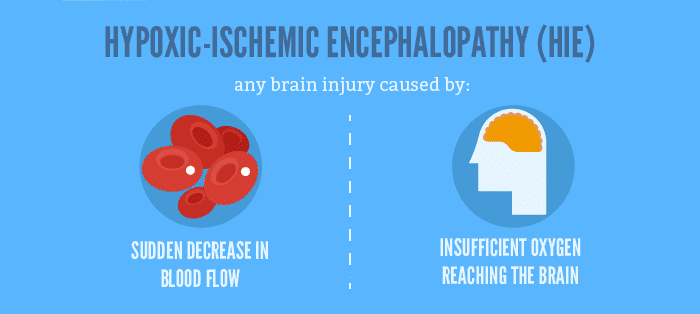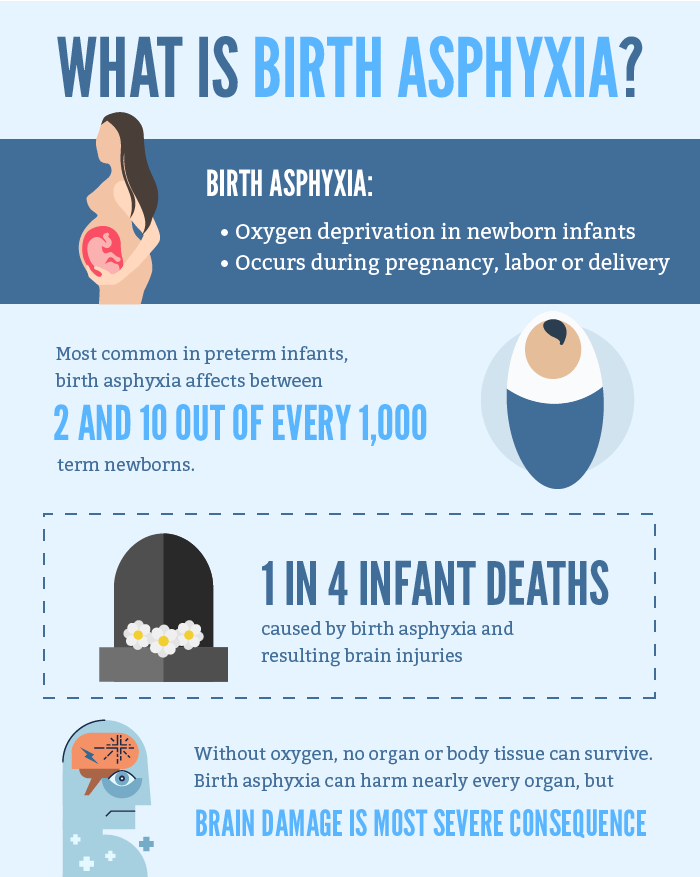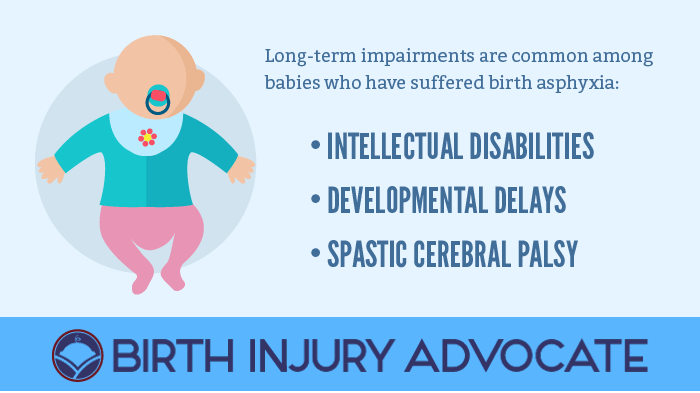Oxygen deprivation is a leading cause of brain damage among infants, along with the lifelong neurological impairments that brain damage often entails. If your child developed brain damage after delivery, our experienced birth injury team wants to help.
- Forty years of trusted trial experience.
- Millions of dollars secured for injured children.
- Contact our attorneys now for a free consultation.
Many birth injuries are entirely preventable. Our attorneys can help you find answers.
There’s no excuse for negligent medical care. Doctors who fail their patients must be held accountable.
"Life-Changers" Birth Injury Advocate helped put my life back together. Thank you.
Birth, or perinatal, asphyxia happens when an infant’s brain and organs fail to receive sufficient amounts of oxygen some time around birth, according to the doctors at Johns Hopkins University. Often caused by a precipitous drop in blood flow, perinatal asphyxia is almost always a medical emergency.
To prevent permanent brain damage, obstetricians, nurses and midwives must quickly diagnose the problem and take immediate action. Oxygen deprivation can be fatal, or lead to permanent muscular and cognitive impairments. Effective treatments, however, can prevent the spread of severe brain injuries, reducing the risk of long-term consequences.
Birth Asphyxia & Brain Injuries
Without oxygen, every cell in the human body would die. In infants, oxygen deprivation threatens the health of every organ and body tissue, at a time when these body parts are still developing. Doctors worry the most about the damage that birth asphyxia can do to that most sensitive of organs, the brain. Severe cases of birth asphyxia will often lead to widespread brain damage, but even minor cases can have lifelong ramifications.
Asphyxia vs. Hypoxia
You’ll usually see this condition referred to as “birth asphyxia,” but that name isn’t always accurate. As a medical term, asphyxia refers specifically to a condition in which the supply of oxygen reaching the body is compromised due to a breathing problem, usually a blockage of the airways.
Hypoxia, on the other hand, is the name we give to reductions in oxygen flow when they impact the body on the tissue level. The brain damage so often caused by birth asphyxia (the state of inadequate oxygen flow) would thus be called hypoxic damage, since the low oxygen supply has come to cause cell death in the brain.
Another way to think of this distinction is that “asphyxia” refers to the cause of a severe medical condition, while “hypoxia” refers to the condition itself. In cases when oxygen supply is completely absent, the condition is known as “anoxia.”
What Is Hypoxic-Ischemic Encephalopathy?
Hypoxic-ischemic encephalopathy is the name given to brain injuries caused by a drop in blood flow, which severely limits the amount of oxygen reaching an infant’s brain. While many unborn children suffer HIE inside the womb, often as a result of low maternal blood pressure or placental problems, infants can also sustain these brain injuries during long and complicated deliveries.
Defining HIE
Hypoxic-ischemic encephalopathy, or HIE, is particularly prevalent among infants who have been deprived of oxygen. In fact, some researchers simply collapse the two conditions, and consider birth asphyxia to be synonymous with hypoxic-ischemic encephalopathy. While this view isn’t universal, HIE is certainly a primary risk of oxygen deprivation among infants, if not an inevitable consequence.

Once a child’s brain has been cut off from oxygen, brain cells begin to die. In a desperate attempt to prevent further damage, the infant’s body will soon begin to redistribute blood flow.
Shunting the vital fluid away from less-important organs, the body redirects blood toward structures like the brain and heart, without which a newborn would die. This preventative measure can only be sustained for so long. If oxygen deprivation continues, or blood flow continues to be impeded, the brain will suffer even greater injury.
Brain Damage Days, Or Weeks, After Delivery
Meanwhile, the infant’s brain cells are having trouble getting rid of their waste products. As these toxins build up, the cells can be damaged further. Some of the cells, however, will attempt to live without oxygen as their primary energy source. Switching into anaerobic respiration, which doesn’t require oxygen, the cells will struggle to survive.
Reperfusion Injuries
These changes can have their own detrimental effects once a child’s blood flow is restored to normal. After a newborn is stabilized, and their blood circulation has returned to an adequate level, brain damage can continue.
In what researchers call a “reperfusion injury,” brain cells become inflamed by a new surge of blood. At the same time, the return of blood flow forces damaged cells to release their built-up toxins, which can kill the cells entirely. And those cells that switched to anaerobic respiration? It’s very difficult for them to switch back, even after receiving appropriate levels of oxygen-rich blood.
Thus newborns can continue to suffer brain damage for days or even weeks after being delivered and stabilized.
Symptoms Of Oxygen Deprivation At Birth
After sustaining mild forms of hypoxic-ischemic encephalopathy, infants can exhibit the following signs and symptoms:
- Abnormal behavior, like difficulty feeding and irritability
- Alternating fits of intense crying and sleepiness
- Increased muscle tone (continuously tensed muscles)
- Abnormally quick tendon reflexes
These signs usually subside after 24 hours, according to the international team of pediatricians at Medscape. But in moderate cases of brain injury, a newborn’s symptoms can last for weeks:
- Lethargy
- Seizures, which usually begin within a day of birth
- Low muscle tone (abnormally relaxed muscles)
- Impaired tendon reflexes
- Absent or impaired Moro reflex (when an infant spreads out his or her arms after experiencing a sudden loss of support)
- Absent or impaired sucking and grasping reflexes
- Temporary apnea (absence of breathing)
Severe Birth Asphyxia Symptoms
Severe HIE is marked by seizures, which often become more intense as time passes, and the child’s brain begins to undergo the secondary stage of reperfusion injury. As cell death continues, these seizures generally subside, but can be replaced by coma.
- Bulging fontanelle (the soft spot on a newborn’s skull)
- Irregular breathing
- Low muscle tone
- Impaired tendon reflexes
- Absence of neonatal reflexes
- Dilated pupils
- Heart and blood pressure problems
Even more terrifying, some newborns will appear fine at first, only to have their condition suddenly deteriorate as the death of brain cells becomes widespread.
What Causes Birth Asphyxia?
Most children will suffer oxygen deprivation while still in the womb, although as we’ve seen, the damage caused by birth asphyxia can persist long after labor and delivery are complete. In principle, anything that decreases a fetus’ or newborn’s blood circulation or air supply can result in birth asphyxia:
- Mucus plug – clogs the infant’s airways
- Fetal stroke – a burst blood vessel in the brain
- Cord prolapse – a delivery complication in which the umbilical cord exits the birth canal before the infant
- Nuchal cord – a complication in which the umbilical cord comes to wrap around the fetus’ neck
- Preeclampsia – high maternal blood pressure caused by pregnancy
- Maternal hypotension – low maternal blood pressure
- Placental insufficiency – a condition in which the placenta fails to deliver the necessary amount of oxygen to a fetus
- Placental abruption – in which the placenta detaches from the uterine wall prematurely, cutting a fetus off from its primary oxygen source
- Placenta previa – in which the placenta covers the cervix
- Oligohydramnios – a deficiency of amniotic fluid surrounding the fetus
- Breech birth – a delivery complication in which the baby presents feet or buttocks first, rather than head first
- Shoulder dystocia – a delivery complication in which the child’s head exits the birth canal, but the infant’s shoulders get stuck behind the mother’s pelvis
In some cases, birth asphyxia is an unavoidable consequence of pregnancy complications. Fetal stroke, for example, is nearly impossible to diagnose before a child has been born. Thus there’s very little that physicians can do to prevent the condition entirely, and treatment options will likely be limited to prompt diagnosis and halting further brain damage. That isn’t always the case, though.

Of primary importance are maternal health conditions, like preeclampsia, which interfere with the way a fetus is nourished inside the womb. Through careful observation, doctors can proactively diagnose many of these conditions – and prevent serious harm. For many families, an emergency cesarean section will be indicated, after physicians have identified signs of maternal hypertension (high blood pressure), placental abruption or another condition that can cause birth asphyxia in the fetus.
Medical Negligence & Neonatal Brain Injury
By the same token, physicians can fail to intervene appropriately. Many birth injuries could have been prevented, or at least limited in their devastating consequences, if only an emergency c-section had been ordered under the necessary circumstances.
After an appropriate diagnosis, severe brain damage can be prevented or mitigated in many cases, through a revolutionary new treatment called hypothermia therapy. By lowering a baby’s body temperature, doctors may be able to halt the physical process that leads to widespread brain injuries – but the treatment must be applied within six hours of an infant’s birth.
Other cases of brain injury develop due to a healthcare professional’s inappropriate actions, rather than a failure to act. Maternal hypotension, for example, can be caused by the excessive administration of anesthesia. Pitocin, a drug commonly used to induce labor, can cause hyperstimulation – when contractions become too long, too strong and too close together. This can lead to fetal distress, and potentially birth asphyxia.
Long-Term Effects Of Birth Asphyxia
Infants can suffer birth asphyxia before, during or shortly after delivery. The condition’s effects are largely determined by how long the child was deprived of oxygen, the extent of brain damage suffered and the treatments that were initiated after diagnosis.

Lengthy periods of oxygen deprivation can lead to organ failure and, in tragic cases, death. Estimates from the early 2000s attribute nearly 1 out of every 4 newborn deaths to brain injuries caused directly by birth asphyxia. Even mild forms of birth asphyxia, however, can increase the risk of a child’s developing attention deficit disorders and hyperactivity – conditions that may not be diagnosed, or even suspected, until years after an infant’s delivery.
Some children will develop serious neurological conditions and developmental delays. Cerebral palsy, a neuromuscular disorder that affects movement and balance, is also possible, as are autism spectrum disorders.
Management Of Neonatal Asphyxia
The first step in properly treating a baby who has experienced birth asphyxia is accurately diagnosing the condition. There are cases, of course, in which a child is born unresponsive, without exhibiting any normal signs of life. This is certainly terrifying and traumatic for parents, but it’s also a good reason for obstetricians to suspect some form of oxygen deprivation.
In other cases, physicians rely on physical examination to confirm a suspected diagnosis of birth asphyxia, according to Seattle Children’s Hospital. After their birth, every child is rated according to the Apgar scale, a simple test that evaluates a newborn baby’s vital signs:
- A – Appearance – the child’s skin color
- P – Pulse – the child’s pulse, or heart rate
- G – Grimace – the child’s reflex grimace response
- A – Activity – the child’s muscle tone
- R – Respiration – the child’s breathing
Low Apgar scores (generally between 0 and 3) that last longer than five minutes could suggest that a child has suffered birth asphyxia.
Birth Asphyxia Treatments
Mild cases of birth asphyxia can usually be managed through breathing support, giving the child’s body time to catch up with its respiratory requirements. In more severe cases, an external, or mechanical, ventilator can be used to oxygenate the child more effectively.
Medications can be administered to improve the child’s blood pressure, as other drugs help to reduce the risk of seizures, which are common in babies who have suffered brain damage and, if allowed to occur, can lead to further brain damage.
Children who experience birth asphyxia due to lung or heart abnormalities are often treated using extracorporeal membrane oxygenation, or ECMO. In ECMO, children are connected to a machine that gradually removes their blood and transports it to an artificial lung outside the body. This mechanical lung pumps oxygen into the blood, removes carbon dioxide and then returns the fluid to the body.
Hypothermia Therapy
When doctors suspect that a child has suffered brain damage, a promising new technique, hypothermia therapy, has been found to reduce the risk for further damage, including the secondary “reperfusion” brain injuries we mentioned earlier. In hypothermia treatments, a baby’s body temperature is gradually decreased in a controlled way, allowing brain cells to repair themselves. Research has also shown that hypothermia therapy is most effective when begun within the first six hours of a child’s life.



